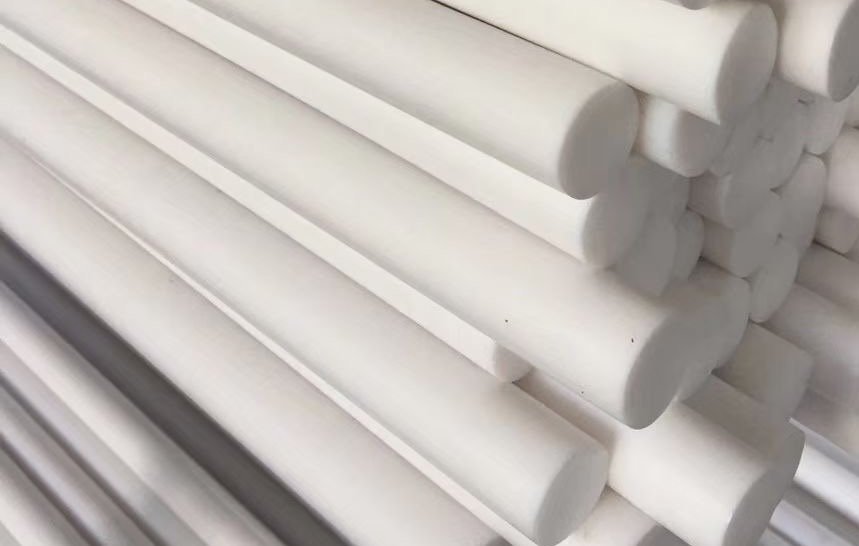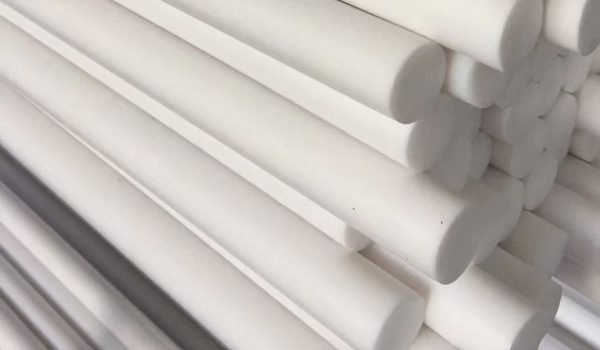PTFE, a fluoropolymer, is gaining attention in many industries. Its high thermal stability and chemical resistance make it great for injection molding. This has led manufacturers to explore using PTFE to create complex shapes and designs.
Using PTFE in injection molding has many benefits. It has low friction and high thermal stability, making it perfect for many industries. But, molding PTFE can be tricky because of its unique properties. Knowing about PTFE and injection molding is key to figuring out if PTFE can be used in these applications.
Understanding PTFE: Properties and Applications
PTFE, or polytetrafluoroethylene, is a synthetic fluoropolymer known for its unique properties. It has many industrial uses. Let’s explore what PTFE is, its key properties, and where it’s commonly used.
What is PTFE?
PTFE is a fluoropolymer with a non-stick surface and high thermal stability. It’s also very resistant to chemicals. Its unique molecular structure makes it perfect for applications needing durability and performance.

Key Properties of PTFE
PTFE has several important properties:
- High thermal stability
- Chemical resistance
- Non-stick surface
- Low friction characteristics
These features make PTFE great for industries like aerospace, medical, and automotive.
Common Applications of PTFE
PTFE is used in many industries because of its unique properties. Here are some common uses:
- Aerospace: PTFE is used in aircraft and spacecraft parts because of its high thermal stability and chemical resistance.
- Medical: PTFE is used in medical devices and equipment because of its non-stick surface and biocompatibility.
- Automotive: PTFE is used in automotive components, like seals and gaskets, because of its low friction and chemical resistance.
These applications show how versatile and valuable PTFE is in different fields.
The Injection Molding Process Explained
The injection molding process is a complex manufacturing technique that uses material science to make many products. It’s popular in many industries because it’s efficient and saves money.
This process involves injecting molten material into a mold. It then cools and solidifies into the desired shape. Understanding material science is key to this process.
Overview of Injection Molding
The injection molding process has several stages. These include melting, injecting, and cooling. Each step needs careful control for high-quality products.
Key Stages in the Process
- Melting: The material is heated until it melts.
- Injecting: The melted material is pushed into a mold.
- Cooling: The material cools and solidifies in the mold.
Advantages of Injection Molding
Injection molding has many benefits. It’s fast, saves on labor, and can make complex shapes. It’s also efficient, with little waste and energy use. Knowing the injection molding process helps manufacturers improve their work.
Can PTFE Be Injection Molded? A Closer Look
PTFE, or polytetrafluoroethylene, is a versatile fluoropolymer known for its unique properties. It has high thermal stability and chemical resistance. But, its processing is challenging, mainly in injection molding.
The high melting point of PTFE and its risk of degradation during molding are big PTFE molding challenges. Manufacturers face these issues.
Challenges in Injection Molding PTFE
These challenges make it necessary to look into alternative techniques for processing PTFE. The traditional injection molding process is not the best for PTFE. This is because of its specific properties.
Alternative Molding Techniques for PTFE
Compression molding and ram extrusion are considered alternative techniques for PTFE. These methods are better for handling PTFE’s high melting point and risk of degradation. Fluoropolymer processing needs careful thought to get the product quality right.
Manufacturers can pick the best method for their needs. This could be due to PTFE molding challenges or using alternative techniques in fluoropolymer processing.
Advantages of Using PTFE in Injection Molding
PTFE, or polytetrafluoroethylene, has many benefits in injection molding. Its special properties make it perfect for many uses. One big plus is its ability to resist chemicals, keeping it safe in harsh environments.
Chemical Resistance
PTFE doesn’t react with chemicals, which is great for tough environments. Its stability at high temperatures adds to its appeal. This makes PTFE a top pick for industries needing top-notch materials.
High Thermal Stability
PTFE stays strong and stable, even in extreme heat. Its ability to resist chemicals and heat makes it a favorite for molding.
Low Friction Characteristics
PTFE also has low friction, which is perfect for smooth movements. Its resistance to chemicals and heat, along with low friction, highlights its value in many fields.
Key benefits of PTFE in injection molding include:
- Chemical resistance to harsh environments
- High thermal stability for extreme temperatures
- Low friction characteristics for smooth movement
| Property | Description |
|---|---|
| Chemical Resistance | Non-reactive nature, suitable for harsh environments |
| Thermal Stability | Maintains structure and properties at extreme temperatures |
| Low Friction Characteristics | Smooth movement and minimal wear |
Limitations of PTFE Injection Molding
PTFE injection molding faces several challenges that limit its use. One big issue is its high viscosity, making it hard to mold complex shapes. This can be a big problem for projects needing detailed designs.
Another major issue is the high cost of producing PTFE parts. The material availability of PTFE is also a concern. This can cause supply chain problems and higher prices. Here’s a quick look at the main PTFE injection molding limitations:
| Limitation | Description |
|---|---|
| Difficulty in molding complex shapes | High viscosity of PTFE makes it challenging to produce detailed designs |
| High production costs | Cost of PTFE material and molding process is high |
| Limited material availability | PTFE material availability is limited, leading to supply chain disruptions and increased costs |
It’s important for industries to know about these PTFE limitations. By understanding the costs and availability of PTFE, manufacturers can make better choices for their products.
Alternative Processing Methods for PTFE
There are many ways to process PTFE, like compression molding, ram extrusion, and blow molding. Each method has its own benefits and drawbacks. The right choice depends on what you need for your project.
Compression Molding
Compression molding is a common way to work with PTFE. It presses the material into a mold to shape it. This method is great for projects that need to be very precise.
Ram Extrusion
Ram extrusion is another way to shape PTFE. It pushes the material through a die to form the shape. This method is flexible and can make complex shapes.
These methods, like compression molding and ram extrusion, have many benefits. They include:
- Improved accuracy and consistency
- Increased flexibility and versatility
- Enhanced material properties and performance
Knowing about these methods helps manufacturers pick the best one for their needs. This ensures the best results and performance.
Industries That Benefit from PTFE Injection Molded Parts
PTFE has many uses because of its special properties. It’s perfect for many industries. For example, the aerospace field uses PTFE in seals and bearings. This is because it can handle high temperatures and resist chemicals well.
Aerospace Applications
In the aerospace world, PTFE is key for parts needing low friction and high heat tolerance. It’s great for aircraft bearings and seals. It also works well in fuel systems because it can stand up to harsh chemicals.
Medical Equipment Manufacturing
Medical devices also benefit from PTFE. Its non-stick nature and resistance to chemicals make it perfect for medical tools. This includes implantable devices and surgical instruments.
Automotive Industry Uses
The car industry also uses PTFE in many ways. It’s found in seals, gaskets, and bearings. Its ability to handle high temperatures and chemicals makes it ideal for engine parts and more.
| Industry | PTFE Application |
|---|---|
| Aerospace | Seals, bearings, fuel systems |
| Medical Equipment | Implantable devices, surgical instruments |
| Automotive | Seals, gaskets, bearings |
Comparisons: PTFE vs. Other Polymers in Injection Molding
Injection molding uses many polymers, each with its own benefits. We’ll look at how PTFE compares to nylon and polypropylene. This will help you see why PTFE is a good choice for injection molding.
In polymer comparisons, PTFE stands out for its chemical resistance and thermal stability. For example, nylon is strong and flexible but not as resistant to chemicals as PTFE.
PTFE vs. Nylon
PTFE and nylon differ mainly in chemical resistance. PTFE is great for harsh chemical environments. Nylon, on the other hand, might not handle these conditions as well.
PTFE vs. Polypropylene
PTFE also outshines polypropylene in thermal stability. Polypropylene is cheaper and has good mechanical properties. But, it can’t handle high temperatures like PTFE.
Choosing a polymer for injection molding depends on the application. Knowing how PTFE compares to nylon and polypropylene helps manufacturers pick the right material.
Future Trends in PTFE Injection Molding
The demand for high-performance materials is on the rise. This is good news for PTFE injection molding. Material science innovations will be key in shaping the industry. Researchers are working to improve PTFE’s thermal stability and chemical resistance.
New molding technology advancements are coming. They will allow for complex shapes and geometries. This will open up new opportunities in aerospace and medical devices. Also, there will be a focus on sustainability, leading to more efficient processes.
Some key trends for PTFE injection molding’s future include:
- Using material science to create new PTFE materials with better properties
- Improvements in molding technology for complex shapes
- More focus on sustainability and reducing environmental impact
The industry will keep evolving. We’ll see new uses for PTFE injection molding. This will be thanks to material science and molding technology advancements. With a focus on sustainability, the future looks bright for PTFE injection molding.
| Trend | Description |
|---|---|
| Material Science | Development of new PTFE-based materials with enhanced properties |
| Molding Technology | Advances in molding technology to enable the production of complex shapes and geometries |
| Sustainability | Growing emphasis on reducing environmental impact and increasing efficiency |
Conclusion: Is Injection Molding of PTFE the Right Choice?
PTFE is a special polymer with amazing properties. It’s great for many industries. But, making PTFE through injection molding has its own set of challenges.
Despite these, PTFE’s benefits like being resistant to chemicals, stable at high temperatures, and having low friction are huge. These make it perfect for certain jobs.
Summary of Points Discussed
We’ve looked at PTFE’s key features and the complex injection molding process. We’ve also talked about the ups and downs of using PTFE in molding. Plus, we’ve checked out other ways to work with PTFE that might be better for some tasks.
Final Thoughts on PTFE Injection Molding
Choosing injection molding for PTFE parts depends on the project’s needs, how many you need, and your budget. PTFE molding isn’t for every project, but it’s a good choice for many.
By weighing the pros and cons and looking at other methods, companies can make smart choices. This helps them create top-notch PTFE products and stay competitive in their markets.




